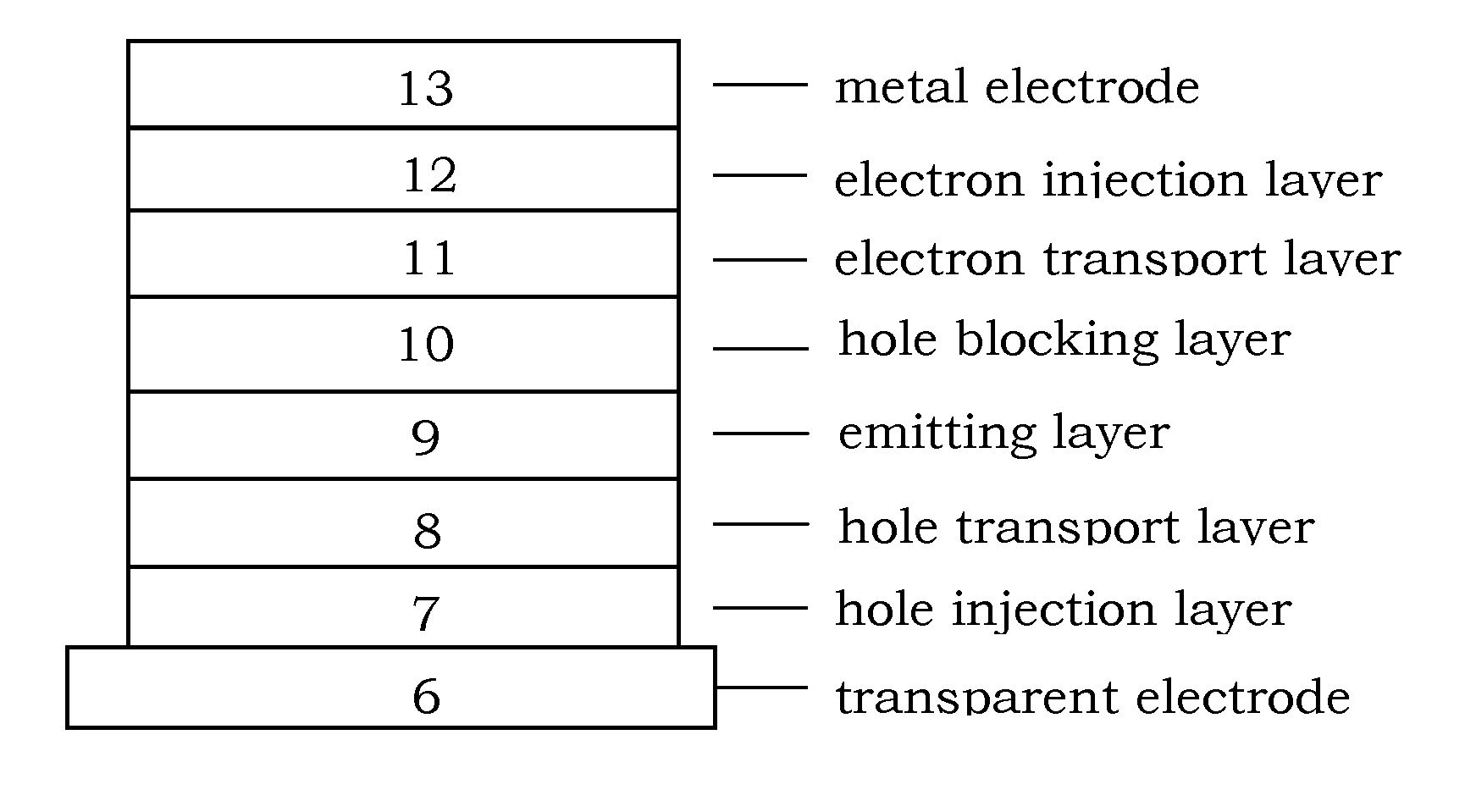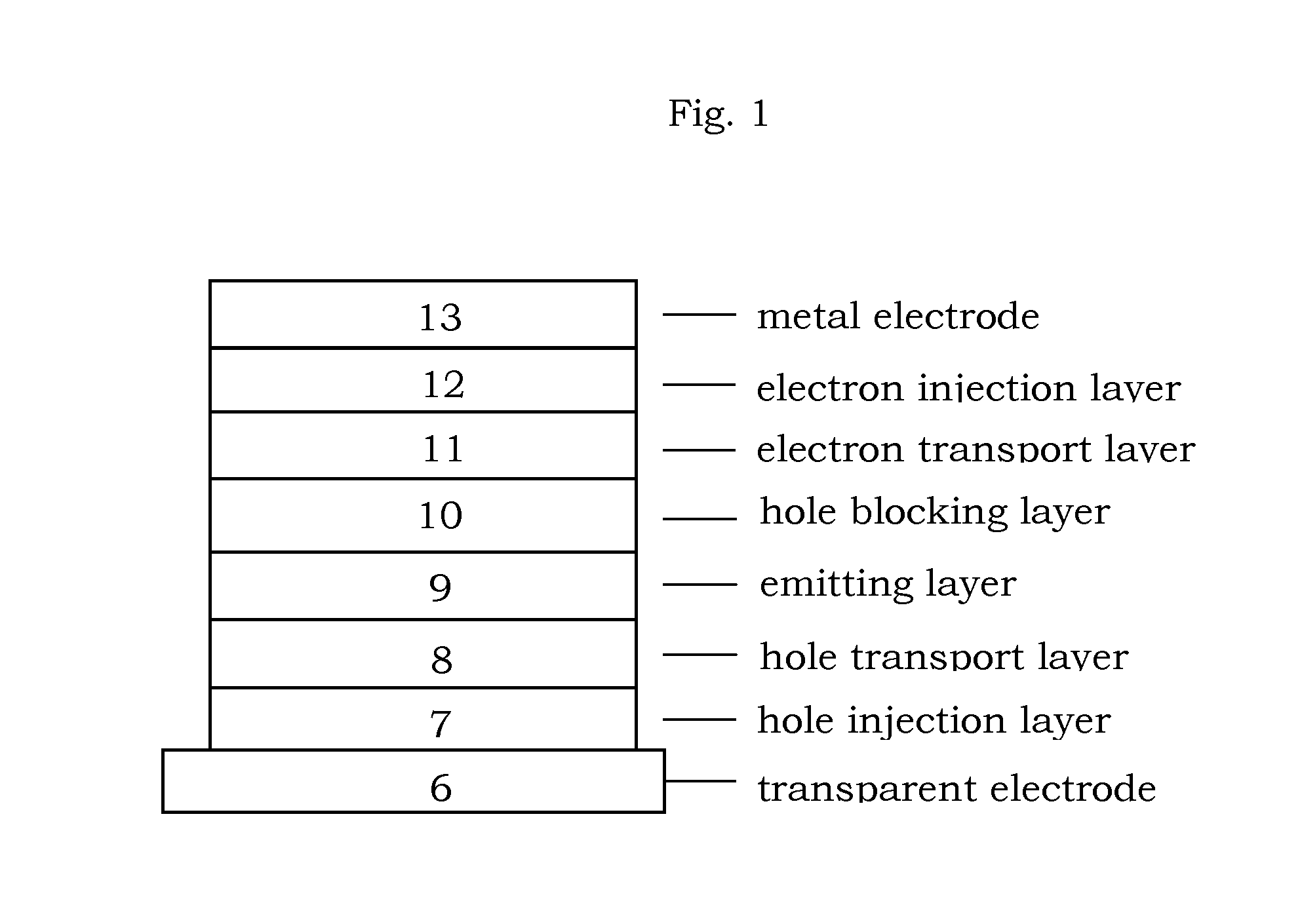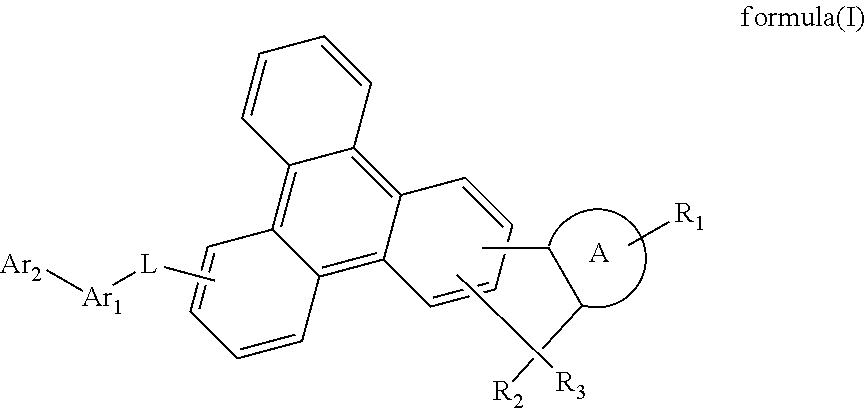Compound for organic electroluminescent device
- Summary
- Abstract
- Description
- Claims
- Application Information
AI Technical Summary
Benefits of technology
Problems solved by technology
Method used
Image
Examples
example 1
Synthesis of EX7
Synthesis of 2-phenyl-4-nitrobromobenzene
[0025]
[0026]2.6 g (12.14 mmol) of 2-phenyl-4-nitroaniline was added to a mixture of 0.92 g (13.35 mmol) of sodium nitrite, 8 ml of sulfuric acid, 9 ml of acetic acid at 0-5° C. and stirred for 2 hours at 0-5° C. Water was added to this mixture and stirred for 1 hr at room temperature. 4.3 g (19.42 mmol) of copper(II) bromide dissolved in 9.3 ml 2M HCl solution was added and stirred for 20 min at room temperature, then heated to 60° C. for 1 hr. After finishing the reaction, the organic layer was extracted with ether and water, washed with brine, dried over magnesium sulfate and evaporated to dryness and the crude was purified by column chromatography on silica to give product (1.5 g, 5.39 mmol, 45.5%) as a white solid.
Synthesis of 2-(5-nitro-[1,1′-bipheny]-2-yl)-9,9-dimethyl-9H-fluorene
[0027]
[0028]A mixture of 40 g (14.38 mmol) of 2-phenyl-4-nitrobromobenzene, 27.7 g (15.82 mmol) of 9,9-dimethyl-9H-fluoren-2-yl-2-boronic acid,...
example 2
Synthesis of EX9
Synthesis of 110,10-dimethyl-6-(4-(10-(naphthalen-2-yl) anthracen-9-yl)phenyl)-10H-indeno[2,1-b]triphenylene
[0037]
[0038]A mixture of 8.6 g (20.3 mmol) of 6-bromo-10,10-dimethyl-10H-indeno[2,1-b]triphenylene, 9.5 g (22.3 mmol) of 4-(10-(naphthalen-2-yl) anthracen-9-yl)phenylboronic acid, 0.5 g (0.4 mmol) of Pd(PPh3)4, 21 ml of 2M Na2CO3, 17 ml of EtOH and 70 ml Toluene was degassed and placed under nitrogen, and then heated at 100° C. for 12 h. After finishing the reaction, the mixture was allowed to cool to room temperature. The organic layer was extracted with ethyl acetate and water, dried with anhydrous magnesium sulfate, the solvent was removed and the residue was purified by column chromatography on silica to give product (7.3 g, 10 mmol, 50%) as a yellow solid. 1H NMR (CDCl3, 400 MHz): chemical shift (ppm) 9.06 (s, 1H), 9.01 (d, 1H), 8.81˜8.88 (m, 3H), 8.60 (d, 1H), 7.93˜8.11 (m, 5H), 7.76˜7.86 (m, 5H), 7.64-7.73 (m, 2H), 7.54˜7.63 (m, 4H), 7.40˜7.48 (m, 2H), 7...
example 3
Synthesis of EX17
Synthesis of 2-(10,10-dimethyl-10H-indeno[2,1-b] triphenylen-12-yl)quinoline
[0039]
[0040]In a 500 ml three-necked flask that had been degassed and filled with nitrogen, 10 g (21.7 mmol) of 9-bromo-10-(4-(naphthalen-1-yl) cyclohexa-1,3-dienyl)anthracene was dissolved in anhydrous THF (150 ml) cool to −78° C., 10.4 ml (26.1 mmol) of n-butyllithium (2.5M) was then added and stir 1 hour, 3.4 g (32.6 mmol) of trimethyl borate was then added and hexane-dichloromethane stir overnight, After finishing the reaction, the solution was extracted with 300 ml of ethyl acetate and 200 ml of water. The organic layer was dried with anhydrous magnesium sulfate and the solvent was evaporated under reduced pressure to give product 7.4 g (80%) as a yellow solid.
Synthesis of 10,10-dimethyl-6-(10-(4-(naphthalen-1-yl)phenyl) anthracen-9-yl)-10H-indeno[2,1-b]triphenylene
[0041]
[0042]A mixture of 8.6 g (20.3 mmol) of 6-bromo-10,10-dimethyl-10H-indeno[2,1-b]triphenylene, 9.5 g (22.3 mmol) of 10...
PUM
| Property | Measurement | Unit |
|---|---|---|
| Transport properties | aaaaa | aaaaa |
| Fluorescence | aaaaa | aaaaa |
| Phosphorescence quantum yield | aaaaa | aaaaa |
Abstract
Description
Claims
Application Information
 Login to View More
Login to View More - R&D
- Intellectual Property
- Life Sciences
- Materials
- Tech Scout
- Unparalleled Data Quality
- Higher Quality Content
- 60% Fewer Hallucinations
Browse by: Latest US Patents, China's latest patents, Technical Efficacy Thesaurus, Application Domain, Technology Topic, Popular Technical Reports.
© 2025 PatSnap. All rights reserved.Legal|Privacy policy|Modern Slavery Act Transparency Statement|Sitemap|About US| Contact US: help@patsnap.com



